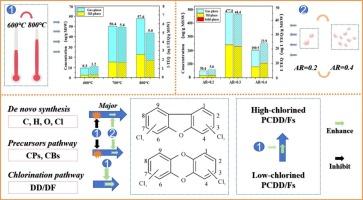Distribution characteristics and formation mechanisms of PCDD/Fs during pyrolysis and gasification of municipal solid waste
IF 7.1
2区 环境科学与生态学
Q1 ENGINEERING, ENVIRONMENTAL
引用次数: 0
Abstract
Pyrolysis gasification (PG) technology is a promising waste disposal technology, which is more efficient and cleaner compared with incineration technology. However, few work has studied the generation characteristics of polychlorinated dibenzo-p-dioxin and furans (PCDD/Fs) and the influencing factors in the PG process. This study investigates the effects of air ratio (AR) and gasification temperature on the generation and distribution of PCDD/Fs during the PG process of municipal solid waste (MSW). PCDD/Fs mainly distribute in the gas- and oil-phase. PCDD/Fs are generated highest levels at 0.3-AR and 700 °C (477.0 ng/g MSW and 44.4 ng I-TEQ/g MSW), which could be attributed to the generation of PCDD/F precursors enhanced by the promotion of oxidation reactions. Gasification temperature positively correlates with PCDD/F generation and generates the highest concentrations of PCDD/Fs at 0.2-AR and 800 °C (57.6 ng/g MSW and 5.0 ng I-TEQ/g MSW). In addition, the increased temperature promotes the generation of high-chlorinated congeners through the chlorination pathway. By adjusting the key parameters of temperature and AR, the inhibition and distribution of PCDD/F generation in the MSW PG process can be effectively regulated.

城市生活垃圾热解气化过程中PCDD/Fs的分布特征及形成机理
热解气化(PG)技术是一种很有前途的垃圾处理技术,与焚烧技术相比,它更高效、更清洁。然而,对多氯二苯并对二恶英和呋喃(PCDD/Fs)在PG工艺中的生成特征及影响因素的研究较少。研究了空气比(AR)和气化温度对城市生活垃圾气化过程中PCDD/Fs产生和分布的影响。PCDD/Fs主要分布在气相和油相。在0.3-AR和700°C (477.0 ng/g MSW和44.4 ng I-TEQ/g MSW)时,PCDD/F的生成最高,这可能是由于氧化反应的促进促进了PCDD/F前体的生成。气化温度与PCDD/F的生成呈正相关,在0.2-AR和800°C时PCDD/F的浓度最高(57.6 ng/g MSW和5.0 ng I-TEQ/g MSW)。此外,温度的升高促进了通过氯化途径产生高氯化同系物。通过调节温度和AR等关键参数,可以有效调节城市生活垃圾PG工艺中PCDD/F生成的抑制和分布。
本文章由计算机程序翻译,如有差异,请以英文原文为准。
求助全文
约1分钟内获得全文
求助全文
来源期刊

Waste management
环境科学-工程:环境
CiteScore
15.60
自引率
6.20%
发文量
492
审稿时长
39 days
期刊介绍:
Waste Management is devoted to the presentation and discussion of information on solid wastes,it covers the entire lifecycle of solid. wastes.
Scope:
Addresses solid wastes in both industrialized and economically developing countries
Covers various types of solid wastes, including:
Municipal (e.g., residential, institutional, commercial, light industrial)
Agricultural
Special (e.g., C and D, healthcare, household hazardous wastes, sewage sludge)
 求助内容:
求助内容: 应助结果提醒方式:
应助结果提醒方式:


